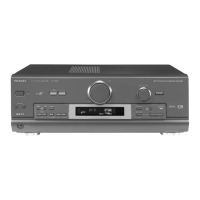
Do you have a question about the Technics SA-DX850 and is the answer not in the manual?
| Type | Receiver |
|---|---|
| Channels | 5.1 |
| Surround Sound Formats | Dolby Digital, DTS |
| Weight | 11.3 kg |
| Input Sensitivity | 200 mV |
| Speaker Impedance | 6 - 16 Ohms |
| Tuning range | FM/AM |
| Input Sensitivity (line) | 200 mV |
| Signal-to-Noise Ratio (line) | 80dB |
| Power Output | 100 W |
| Power Output (6 ohms) | 100W per channel |
| Frequency Response (Tolerance) | +3 dB |
| Inputs | 2 digital (1 optical, 1 coaxial) |
| Signal to Noise Ratio | 80 dB |
| Output | 5.1 channel speaker outputs, subwoofer output, headphone output |
| Input Impedance | 47k ohms |
| Digital inputs | 2 |
| Video Inputs | 3 x composite |
| Video Outputs | 1 composite |
| Dimensions (WxHxD) | 430 x 150 x 380 mm |
| Dimensions | 430 x 150 x 360 mm |
General advice on unit placement to avoid damage and ensure longevity.
Precautions against using incorrect voltage sources to prevent fire.
Guidelines for safe connection and handling of the AC power cord.
Warnings against inserting foreign objects or liquids into the unit.
Instructions on when to contact a dealer for repairs and self-repair warnings.
Step-by-step guide to replacing the fuse in the UK mains plug.
Explanation of wire colors and terminal connections for UK plugs.
Essential warnings about plug suitability and electrical shock risks.
Detailed identification and function of buttons and indicators on the main unit.
Explanation of the various indicators shown on the receiver's display.
Guides for connecting televisions, VCRs, and DVD players using various cables.
Instructions for connecting a 6-channel analogue audio source, typically from a DVD player.
Instructions for connecting turntables, CD players, and tape/MD decks.
Guide for connecting digital sources like satellite receivers or CD players.
How to change digital input settings for optimal source recognition.
Instructions for connecting indoor and outdoor FM and AM antennas.
Guidance on installing outdoor antennas for better reception.
Guidance on positioning front speakers for optimal stereo imaging.
Recommendations for placing center and surround speakers for immersive sound.
Tips for positioning the subwoofer for the smoothest low frequency performance.
Instructions for connecting the center speaker and its impedance requirements.
Instructions for connecting surround speakers and their impedance.
Guidance on connecting passive and active subwoofers, and amplifier needs.
Adjusting speaker size (LARGE/SMALL) and distance for accurate sound.
Configuring bass cutoff frequency and dynamic range compression for optimal audio.
Setting digital input sources and adjusting display brightness.
Step-by-step guide to begin customizing receiver settings.
Detailed procedure for setting speaker size and distance parameters.
Instructions for adjusting bass filter cut-off and dynamic range compression.
How to configure CD, DVD, and TV digital input terminals.
Enabling low impedance mode for speakers with impedance under 6 ohms.
How to output a test signal to each speaker for level adjustment.
Adjusting the volume level for each speaker channel to match front speakers.
Explanation of DSP capabilities, including Dolby Digital and DTS decoding.
Using stereo mode for stereo sources or surround sources with two speakers.
Selecting surround mode for digital or Dolby Surround sources.
Adjusting PCM FIX or DTS FIX modes if signal recognition issues occur.
Using SFC modes like HALL, CLUB, LIVE, THEATER for enhanced sound.
Fine-tuning speaker levels within selected SFC sound modes.
Setting the delay time for surround speakers in SFC modes.
Switching between analogue and digital input sources for playback.
Choosing appropriate DSP sound modes like STEREO or SFC for playback.
How to adjust volume, start playback, and general listening notes.
Switching to analogue input for DVDs with multi-channel audio.
Instructions for connecting and using a second set of speakers (B terminals).
Modifying bass, treble, and left/right speaker balance for optimal sound.
Steps for connecting headphones and adjusting volume for private listening.
Fine-tuning the subwoofer volume level for enhanced bass response.
Activating the tape monitor for use with external audio processors like equalizers.
Step-by-step guide to tuning radio stations by frequency.
Tips for better FM reception, DSP defeat, and avoiding interference.
Method for directly entering a desired radio frequency using numbered buttons.
Automatically presets receivable FM and AM stations into memory channels.
Manually tuning and assigning stations to specific memory channels.
How to select preset radio channels using the unit or remote control.
Displays PS, PTY, EON, and RT information from RDS-equipped stations.
How to view station name, program type, and radio text.
Searching for FM stations broadcasting specific program types (PTY).
Automatically tuning to related stations broadcasting RDS signals.
A list of available program types for PTY search and display.
Procedure for recording sources to tape or MD decks via analogue terminals.
How to monitor sound being recorded onto a tape deck using tape monitor.
Configuring the unit to turn off automatically after a set time.
Programming the unit to turn on automatically after a specified duration.
How to check remaining timer time and cancel active timers.
Accessing on-screen information to diagnose and remedy operational issues.
Procedure to reset all settings to their original factory defaults.
Instructions for cleaning the exterior surfaces of the receiver.
Diagnosing and resolving common issues like no power, no sound, or display errors.
Resolving issues related to DSP sound modes not working or being unavailable.
Addressing problems with tuning, noise, interference, and AM frequency steps.
Technical details on power output, frequency response, and impedance.
Technical details on tuner frequency range, sensitivity, and selectivity.
Technical specifications for video output, power supply, dimensions, and consumption.
